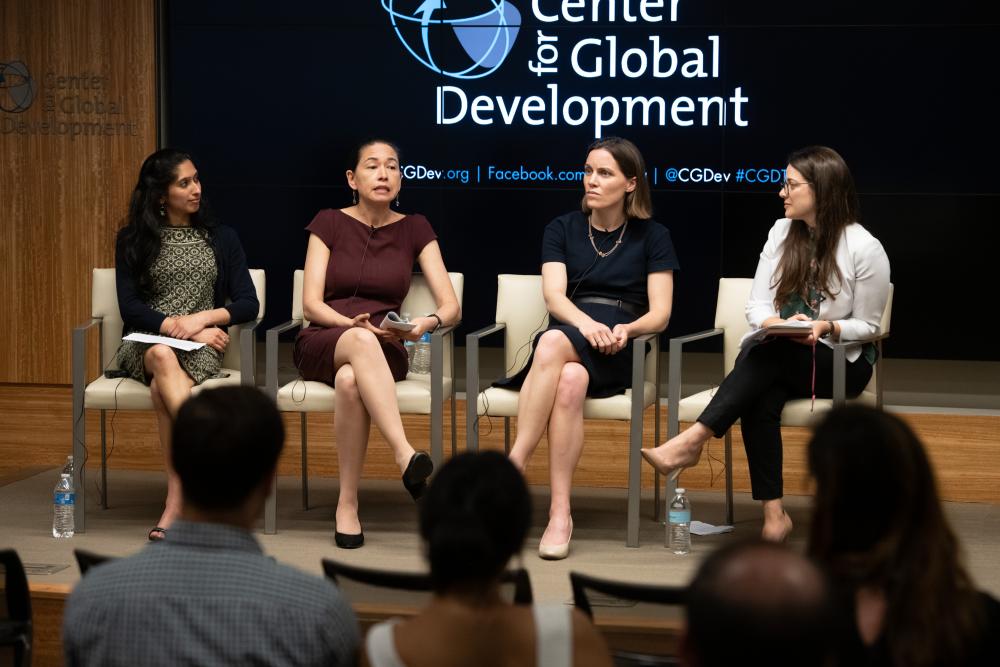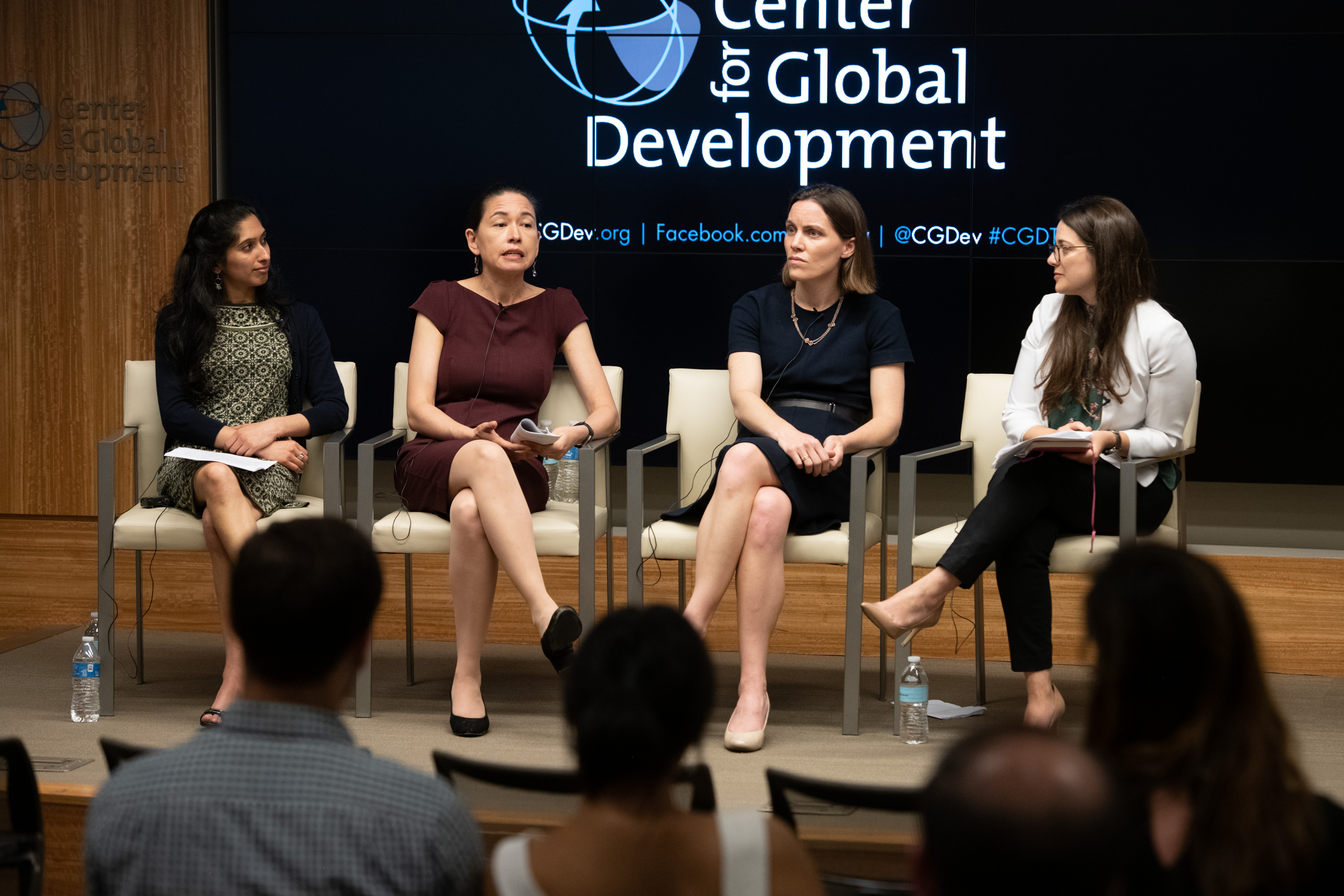Recommended
Everyday decisions during pregnancy and the early years of parenting often spark contentious debates and tremendous anxiety about the best behaviors to support the health and wellbeing of babies and children. Amidst the overwhelming amount of advice, conventional wisdom, and recommendations—often without a clear basis in the evidence—parents and prospective parents around the world are often left to their own devices to navigate a range of conflicting pressures to do what’s best for their children, their families, and themselves. A recent CGD panel explored the role of evidence to inform and empower decision-making in pregnancy and parenting—both at the individual level and from a policy and programming perspective.
The panel, moderated by CGD policy fellow Carleigh Krubiner, included Emily Oster, Professor of Economics at Brown University (who shared highlights from her recent book, Cribsheet: A Data-Driven Guide to Better, More Relaxed Parenting, from Birth to Preschool and Expecting Better); Lisa Noguchi, Director of Maternal Newborn Health at Jhpiego; and Pooja Sripad, Associate at Population Council. The panelists explored what the evidence actually supports, where more evidence is needed, and how different types of evidence and knowledge brokers play a role in promoting evidence-informed practice in pregnancy and parenting.

Below we highlight some of the key themes and points of discussion from the panel:
1. What does the evidence actually say about best practices in pregnancy and parenting?
It turns out that there is a lot variability in the quality and quantity of evidence behind different commonly recommended practices. There are some practices, such as childhood vaccination, where the evidence is both robust and clearly in favor in almost all contexts. There is a tremendous amount of evidence from well-designed studies supporting the safety and protective benefits of vaccinating children to protect them from infectious diseases. These benefits apply to children no matter where they live, whether in low- or high-income country settings, and not only provide direct benefits to children vaccinated, but also help keep unvaccinated individuals in the population safe, through the effects of herd immunity.
Other practices are context specific and may require a more nuanced approach to understand the benefits associated and what conclusions can be drawn. A good example is breastfeeding, a topic with a lot of research as well as various claims that it supports everything from better health outcomes to higher IQ. But when you interrogate the evidence, only some of these claims hold, and the impact size differs by setting. It turns out that certain health benefits of breastfeeding for both mom and baby are widely supported, including protection of infants from infectious and diarrheal diseases, and a lower risk of breast cancer for mothers.
Yet the benefits of breastfeeding are not even and can vary by context. In developing countries, the benefits of extended exclusive breastfeeding are often substantially greater, particularly because the use of formula without access to safe water increases risk of diarrheal diseases. On this issue, Noguchi said:
Yet in higher-income countries, where water and sanitation do not pose the same issues for formula feeding, the comparative benefits of breast feeding are not as pronounced. Moreover, the evidence behind certain claims of longer-term health benefits or improved IQ scores in higher-income countries may be inherently flawed with selection bias, given that wealthier and more educated women in these settings tend to be more likely to breastfeed. In her book, Oster presents the facts for women in more developed settings so that they can determine what’s right for them. She states:
There are also cases where the evidence has completely debunked the conventional wisdom. A good example is the case of food allergies. For a long time, parents were advised to avoid introducing peanut products to children, especially those at high risk of having an allergy. This was the case for Oster in her own experience with her first child. However, a randomized controlled trial that tested early exposure to peanuts showed instead a dramatic reduction in peanut allergies! Accordingly, the recommendations for parents about feeding were changed. This shows the value that evidence can provide to ensure not only that we are supporting the right types of approaches, but also to avoid approaches that end up producing more harm than good.
2. We still have serious evidence gaps to address.
There are also areas where evidence is severely lacking. Oster noted:
This is an area that Noguchi and Krubiner have worked on extensively to ensure pregnant women are appropriately and ethically included in various research studies so that we have much needed evidence on the safety, dosing, and effectiveness of medications that women may need during their pregnancies. The absence of data in this area is not only disempowering and unjust for women and clinicians trying to manage health needs in pregnancy; it can also lead women to forego or discontinue medication necessary for the health of both mom and baby, based solely on fear. The panelists also discussed the need for more evidence on how to predict and prevent premature births, pre-eclampsia, and eclampsia—which could help prevent a large amount of maternal and newborn morbidity and mortality.
Evidence gaps not only limit our ability to address health needs and answer patient questions. They can also lead to increased practice of harmful behaviors as well as greater anxiety, pressure, and shame for women as parents. As Noguchi pointed out:
A dearth of data creates the breeding grounds for misinformation and reinforcement of negative gendered impacts on women and girls.
Another point raised during the panel was the need for data that is more patient- and parent-centered, including data that takes parents and other family members into account. Oster lamented:
Sripad also highlighted the need for more research into health systems, with support for facilities to build best practices into the existing health system.
3. Evidence isn’t just about the numbers—qualitative data is also critical.
Panelists stressed throughout that data is not solely about numbers. Qualitative data is often needed to complement the quantitative evidence base. Quantitative data helps us understand the frequency of a certain phenomenon or the efficacy of a certain practice, but we often need qualitative evidence to better understand the drivers of why a certain problem is occurring, and what strategies are most suitable to support positive behavior change. Sripad used the example of surveys that ask patients to rate their level of satisfaction with their healthcare, pointing out that this information is only useful if we also ask why healthcare experiences are satisfactory or dissatisfactory, so that we understand what needs to change.
Additionally, qualitative data can help develop more nuanced quantitative instruments to ensure that we measure the things that matter most to parents and children, as Sripad discussed with regard to her qualitative work to examine trust in the context of facility-based births. Dr Sripad found that understanding and defining what respectful and dignified maternal care looks like, helps to shape the development of scales to measure trust in this context, a concept that has been notoriously difficult to assess quantitatively. Noguchi commented that the WHO, in an effort to capture women’s true needs in its recommendations, is now including qualitative studies as part of the evidence review when developing new guidelines for antenatal and intrapartum care. Qualitative research is an important tool for addressing the experiences of women as they navigate pregnancy and parenting decisions, ensuring that their voices are heard in the development of relevant evidence-based guidelines.
4. The role of different knowledge brokers can be critical to the uptake of evidence-based practice
The existence of evidence alone is not enough to ensure that parents can make informed and empowered decisions. The ways in which people receive and interact with information, and the “knowledge brokers” conveying the evidence, can play a huge role in decision-making. The panelists discussed the range of knowledge brokers influencing how parents consume, interpret, and act on information, including care providers, family members, peers, and the media. The panel acknowledged the challenges providers face in communicating data to patients, often with limited windows of time to share complex and nuanced information. But they also highlighted how professional medical societies can help providers stay up-to-date with the evidence base as it evolves and develop accessible messaging to relay information to patients.
There was also an extensive discussion of how novel approaches to involve family members and peer groups in communication activities can lead to broader uptake of beneficial practices, and potentially mitigate the impacts of misinformation or “blame and shame” approaches. For instance, studies of group antenatal care have shown improvements in uptake and health outcomes. Group models of care delivery and health communication can help build much needed social support and provide an opportunity for health providers to discuss current evidence and recommendations in non-judgmental ways, allowing women to comfortably share questions and experiences.
There is also an important role for the media to play, especially since there is a tendency to overhype certain findings and sensationalize studies. Oster said:
When the media is reporting on a new study, it is important to consider if the findings were statistically significant and clinically meaningful, and to contextualize new findings in the broader evidence base. Without this kind of responsible reporting, the media may further add to the burden placed on parents to do every possible thing that may improve their children’s chances—even when the tradeoffs may be high and the benefits small or nonexistent.
If you’d like to learn more, you can watch the full recap of the event here. And stay tuned to the CGD Podcast to hear more from Emily Oster on evidence use in pregnancy and parenting.
Disclaimer
CGD blog posts reflect the views of the authors, drawing on prior research and experience in their areas of expertise. CGD is a nonpartisan, independent organization and does not take institutional positions.






